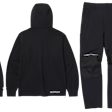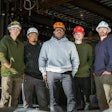
As seasonal temperatures start heating up, jobsite apparel comfort transitions from needing to keep warm to staying cool. Part of that may entail adjusting apparel choices from long pants to shorts.
There are arguments to be made on both sides as to whether it is advisable to wear shorts on the job site. The answer is: it depends on the worksite and job function.
Consider the Dress Code at Work
The Occupational Safety and Health Administration (OSHA) enables the employer to set the dress code except in construction situations involving asbestos and lead, where full body protection is required. Compliance officers need to balance the need for personal protective clothing such as long pants during hot tar and asphalt operations against the need for clothing appropriate for extreme environmental conditions such as significantly warm weather.
Other considerations include exposure to sun, chemicals and other irritants and the possibility of the skin coming into contact with machinery or other elements where fire-resistant clothing is necessary.
OSHA’s 1926.95(a) indicates “Protective equipment, including personal protective equipment for eyes, face, head, and extremities, protective clothing, respiratory devices, and protective shields and barriers, shall be provided, used, and maintained in a sanitary and reliable condition wherever it is necessary by reason of hazards of processes or environment, chemical hazards, radiological hazards, or mechanical irritants encountered in a manner capable of causing injury or impairment in the function of any part of the body through absorption, inhalation or physical contact.”
Some jobsite owners’ policies will dictate whether shorts are permitted on a worksite. Consider the Personal Protective Equipment (PPE) policy at Princeton University, for example: “All workers must wear shirts with sleeves, long work pants, and sturdy work shoes or boots when working on a construction or renovation site. Sleeveless or tank top shirts, short pants, sweatpants, sneakers, sandals, and high-heeled or open-toed shoes are not permitted.”
When wearing shorts on outdoor job sites, keep in mind that UV rays are a factor and sunscreen with high UV ratings may be advisable. However, greasy types of sunscreens might set up a worker for a slip of some sort or other incident.
Requiring employees to wear certain clothing in extremely hot conditions also can be harmful. Jeans, pants or even fully protective clothing could make conditions unbearable if temperatures reach 80 degrees or higher. OSHA advises employers to consider that factor, as well as any hazards, when setting a dress code. Among the many guidelines that the National Institute for Occupational Safety and Health offers in protecting workers from heat stress, clothing plays a role insofar as appropriate clothing should be breathable, light-colored, and loose-fitting. Certain protective clothing may increase the heat stress risk. Cotton clothing can be soaked in water to aid cooling. The amount of time exposed to heat is a driving factor in the number of breaks that should be taken. Hydration plays a major role in working outside.
Choosing Work Shorts for Construction
In situations where work shorts are appropriate, options abound.
Blaklader’s options include high visibility shorts made from a poly-cotton fabric with high-quality Level 2 3M reflective tape. Shorts include utility pockets, bellowed and CORDURA-lined back pockets, hammer loop and cargo/tool pockets on both legs. Certification is ANSI/ISEA 107-2010 Class E.
For those not requiring high-visibility shorts, another Blaklader option is the brand’s X1600 available as shorts. The shorts have two free nail pockets in CORDURA with tool loops that can be worn inside the trousers. Leg pocket with telephone pocket in water-resistant material also is featured.
Carhartt Force Relaxed Fit Ripstop Cargo Short is constructed of a lightweight ripstop with Force technology to wick away sweat and FastDry technology for all-day comfort. It features Rugged Flex stretch technology and a gusseted crotch for ease of movement. Fabric construction is 7-ounce, 58% cotton, 39% polyester, 3% elastane. Other features include belt loops, utility loops and pockets for tools and cell phone storage.
For women in construction work, Dovetail Workwear offers Day Construct Short Ultra Light Flax Ripstop. The mid-rise relaxed leg shorts feature the brand’s EZWaist, a double-button waistband, higher back, reinforced front pockets and a zip pocket. The 7-ounce shorts have a fabric content of 90% cotton, 8% nylon, 2% Spandex. They are stain- and water-resistant and offer UPF 50 protection.
Check out a full, head-to-toe collection of workwear products on IRONPROS!















